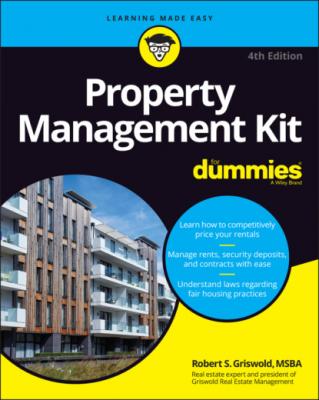Property Management Kit For Dummies. Robert S. Griswold
Чтение книги онлайн.
Читать онлайн книгу Property Management Kit For Dummies - Robert S. Griswold страница 31
 of a more-durable product when making renovation decisions. Cleanliness is essential. If you rent a dirty unit, new tenants will rightfully assume that your standards are low and will show a lack of care during their tenancy.
of a more-durable product when making renovation decisions. Cleanliness is essential. If you rent a dirty unit, new tenants will rightfully assume that your standards are low and will show a lack of care during their tenancy.
One of the best ways to maximize your rental income is to develop a system to improve your efficiency by completing your rent-ready process in minimum time. But you may be so overwhelmed by the amount of work you need to get done in the amount of time you have that you don’t consider the order in which you should proceed. I recommend that you follow these steps in order to maximize your time and efficiency:
1 General cleaning (hauling away anything left behind by your vacating tenant)
2 Maintenance (which includes inspecting safety items, making repairs, and installing upgrades)
3 Painting
4 Final cleaning and sanitation
5 Carpet or floor-covering cleaning
General cleaning
As soon as old tenants move out, clean the vacant rental unit. During this initial cleaning, you should
Remove all trash left behind by the former tenants, including anything remaining in drawers, cabinets, and closets.
Wipe down countertops and shelves.
Sweep or vacuum the floors.
Wash the windows, screens, window coverings, and doors.
Clean out the storage areas, including the attic, basement, or garage as applicable.
Maintenance
Maintenance is more than just fixing something that’s broken. A comprehensive maintenance approach also includes inspections of all safety items before renting your property to make sure that they’re in place and working as intended. Although you’ll routinely handle basic repairs, you should also look for opportunities to perform preventive maintenance to improve the performance and life span of your building systems. You also need to evaluate whether renovations and upgrades are cost-effective.
The following sections help you figure out which safety items you need to check and which maintenance tasks require a closer look. They also help you determine whether renovating or upgrading your property is worthwhile and, if so, what direction you should go in with your changes.
Inspecting safety items
Although tenants need to take an active role in and have ultimate responsibility for their own safety, you need to check all safety items upon unit turnover. The most basic safety items in virtually every residential rental unit are door locks, window locks, and smoke detectors. Be sure that the following items are in place and working before the new tenant takes occupancy:
A small fire extinguisher: Even if one isn’t required by code, I recommend that each rental unit have a fire extinguisher. Although the tenant may not use the fire extinguisher properly, most life-saving professionals advise that one is worth having, because using a fire extinguisher quickly can keep a fire from spreading. The tenant should ensure that someone has contacted 911 or the appropriate agency before attempting to put out the fire, of course.
Adequate locking mechanisms: Many local and state building codes have specific requirements concerning the types and specifications of door lock sets. Recent trends in legislation require all windows that open and are accessible from the ground to have proper window locks. Windows and screens should be in place and in good condition. The primary purpose of screens is to keep the elements and insects out, but screens can also have some value as a crime deterrent.
Smoke and carbon-monoxide detectors: These items are inexpensive and extremely important to your tenants’ safety. Check with your local fire department for its code requirements; some departments expect detectors to be electrically hard-wired, and others still allow battery-operated units. Smoke detectors with removable batteries are no longer available. All new units have sealed batteries that can’t be replaced, and they have expiration dates, which mean that the units need to be replaced on or before those dates.Contact your local fire safety or building officials for the latest info on fire and safety codes. Many of the rules have changed in recent years, particularly regarding the number and locations of required smoke detectors. Consider complying with any recommendations, even if the action isn’t required in existing rental units. Carbon-monoxide detectors are just becoming required in many areas, for example.Make sure that your records clearly indicate that you tested all the detectors and found them to be operating properly before your new tenant moves in. Afterward, the tenant must not disconnect or disable the detectors in any way. The tenant is also responsible for replacing the batteries (if the smoke detectors are the older variety, with removable batteries), regularly testing the detectors, and alerting you in writing if they don’t operate properly.
Other important items: Your preparation work should also include testing the GFCI or GFI in kitchens and baths, plus any other safety items, such as radon detectors.If the municipality in which your rental property is located requires that tenants always have access to the roof, check with local agencies about possibly restricting that access for tenant safety. You may be able to install panic hardware that meets the code requirements of access but sounds an alarm if the door to the roof is opened.
Although doing so is not required, if you’re ever sued, having written confirmation that all safety items were operating as intended at move-in can be helpful.
Performing turnover maintenance